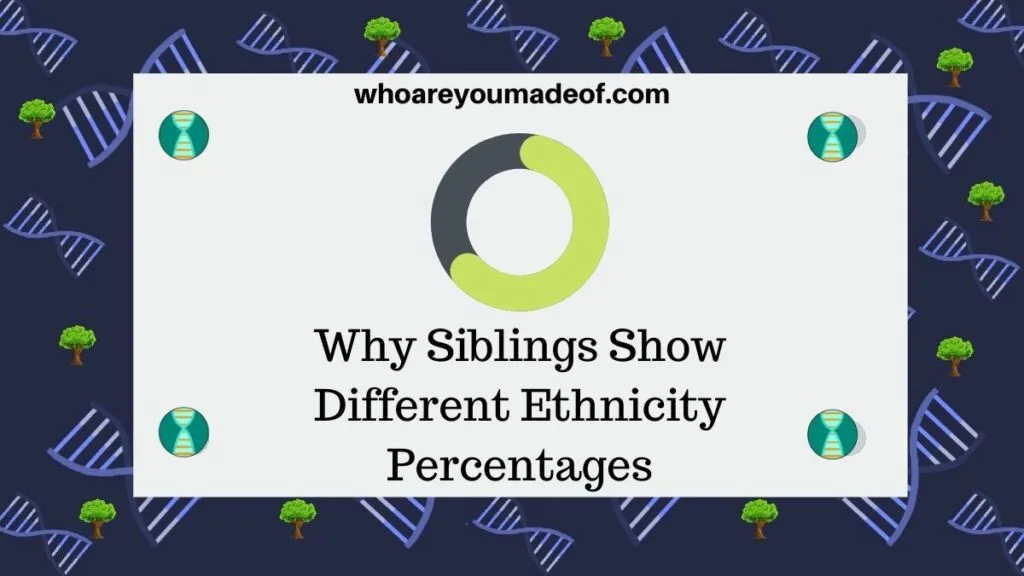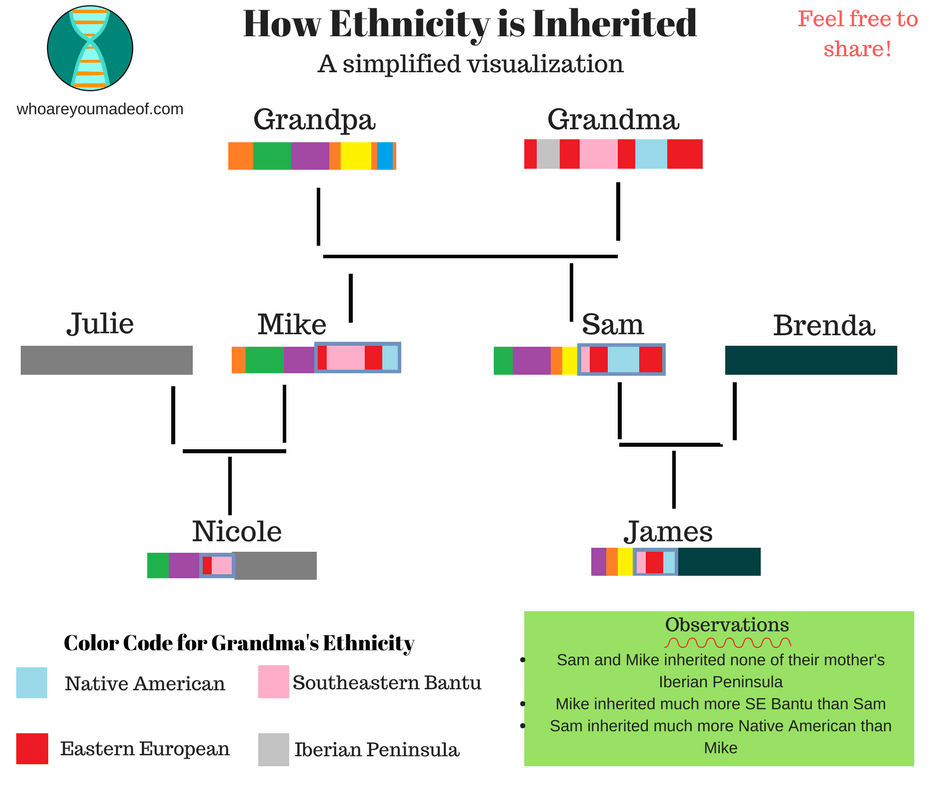Did you know that siblings will usually show different percentages matching the regions on their ethnicity estimates? In fact, they can even have regions on their results that their siblings don't have.
Does this mean that the results aren't accurate? Or could it mean that they are not full siblings?

It's normal for siblings to show different ethnicity percentages, and now you want to understand why. In this post, I will explain how this happens, and why it's actually a huge benefit to you that your sibling has DNA that doesn't match yours.
How siblings inherit different ethnicity
Each person inherits almost exactly 50% of their DNA from their mother and father, and the percentage of DNA that they inherit equals about 50% of each parent's DNA. The DNA that a person inherits from each parent is what is tested in a DNA test in order to determine where our ancestors may have lived.
The results of these autosomal DNA tests usually consist of at least two parts: an ethnicity estimate and a DNA match list. The topic of this post concerns the most popular aspect of our results, which is the ethnicity estimate.
The way that DNA testing companies test for ethnicity is rather complicated, and the way DNA is inherited is even more so. With that said, there is a simple way to imagine how the process works, and why two siblings will have major differences in their DNA.
As I mentioned above, each person inherits half of each of their parent's DNA. However, full siblings will not share all of their DNA with each other because they inherit a substantially different combination from their parents.
Some DNA shared between siblings will overlap, while some DNA inherited by a full sibling from the same parents will be different and not shared with the other sibling.
Imagine that there are two big bowls filled with numbered marbles. One bowl has pink marbles (your mother's DNA), and the other has blue marbles (your father's DNA). If you were to choose half of the pink marbles, and half of the blue marbles - randomly - write down all of the numbers that you chose, a good deal of the numbers that you write down would match the ones that your sibling chose if they were to complete the same process.
Obviously, for our example, you would have to put the marbles back before your sibling started to choose.
All of these marbles came from the ancestors of your parents, and groups of these marbles could show a particular ethnicity. This means that you will have many marbles, or much of your ethnicity, in common with your sibling.
Depending on your parents' ancestry, there could be groups of marbles that either you or your sibling chose that the other one doesn't have. This concept works even in families where there are many children.
Furthermore, there will always be marbles that none of the children chose.
Visual example of why siblings have different ethnicity
For many people, a visual example works best for understanding the way that ethnicity is passed down through families. In the image below, you can see how two siblings, Mike and Sam, both inherited 50% of each of their parents' DNA.
The ethnicity is represented with colors, and you can see how Mike and Sam share Native American, Southeastern Bantu, and Eastern European DNA, but have different sized segments (representing percentages) of those amounts. Furthermore, you can also see that the children of Mike and Sam (James and Nicole), who are first cousins, will show even less of the ethnicities of Grandma and Grandpa.

How does the way ethnicity is inherited affect my DNA results?
The way that DNA is passed down has a huge effect on your DNA results. You didn't inherit 50% of each of your parents' DNA, and your parents didn't inherit 50% of their parents' DNA, and your grandparents didn't inherit 50% of their parents DNA.
Each generation, some DNA is lost forever. This means that your DNA results, while very useful, are incomplete. They are only a snapshot of a small portion of your true ancestry.
The only way to try to make up for this effect of "recombination", as it is called is to have as many siblings test as possible. If your parents are able to take a DNA test, that's great, but if you can test your aunts and uncles, that's even better.
The more people in your family who can do a DNA test, the more complete the picture of your recent ancestors' ethnicity you will be able to piece together.
If you think you would like to purchase another DNA test for a relative, if you use either of the links below, I will get a small commission at absolutely no extra cost to you that helps me support this site:
Why is it a good thing that my sibling has DNA that is different than mine?
Since your sibling inherited some DNA from both of your parents that you did not inherit, it is a benefit that they also do a DNA test. Depending on your family's background, there is a good chance that their ethnicity estimate will include something that was not included on your own test.
Additionally, even if their ethnicities are similar to yours, the percentages will almost definitely be different, giving you a different perspective on how far back certain ancestors might be.
Even more interesting than ethnicity is the fact that your siblings will have many different DNA matches than you do. If you looked at that image towards the beginning of this post, you noticed DNA segments that one brother has that the other brother does not have.
Those same DNA segments that your sibling has which will give an insight into ethnicity will also match DNA relatives at the third cousin level and more distant cousins that don't match the segments that you inherited.
The end result of all of this matching and not matching is that you will end up learning more about your ancestors, through the family trees of your DNA matches, than you could just on your own with only your DNA results. I call this "casting a wider net" in genetic genealogy.
Conclusion
I hope that this post helped you understand a little about how siblings can have different ethnicity results, and why it is actually a positive rather than a negative. There is so much to learn from your siblings' DNA results!
If you have any questions about anything that you have read in this post, or would like to share your own experience comparing your ethnicity to that of your siblings, I would encourage you to leave a comment below.
Thanks for stopping by!

